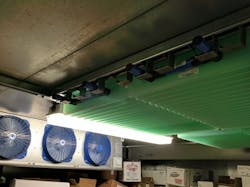Thermal storage is gaining ground in refrigeration applications, providing demand management for one of utilities’ most energy-intensive industries.
Industrial refrigeration consumes more energy per cubic foot than any other utility load, said Collin Coker, vice president, sales and marketing, Viking Cold Solutions.
Thermal energy storage generally involves salt water-based solutions that can absorb heat and supplement refrigeration. In these applications, thermal storage offers cost advantages over lithium ion batteries, he said.
“From the utility’s perspective, refrigeration is a very intense load and these commercial and industrial sites are located all over the place,” he said. The grocery stores and other cold storage operators often pay high demand charges in areas like California and New England, he added.
“We can shift the load from peak daytime usage to night time usage, and also reduce overall consumption by running refrigerators at night, when they run more efficiently,” he said.
Who’s using thermal storage
Viking Cold Solutions and Axiom Energy are participating in demand management programs to provide thermal storage in refrigeration applications.
Viking Cold Solutions partnered with Eversource to install a system to reduce the Greater Boston Food Bank’s peak demand, realizing a 75 percent reduction in consumption during the program period, the company said. The partnership is part of Eversource’s Demand Reduction Demonstration in Massachusetts.
The company also has worked with Southern California Edison, San Diego Gas and Electric and other utilities. Viking Cold Solutions is participating in the California Energy Commission’s net zero project, a demonstration designed to help a Whole Foods store achieve net zero energy. Other companies are participating in that project, providing renewable energy and other technologies besides thermal storage.
“The hope is to create a blueprint for grocery stores, and have a net zero energy impact,” Coker said.
“Due to shifting demand patterns and the addition of more intermittent renewable power generation onto the grid, the energy storage market is growing quite rapidly,” said Coker. “The first quarter of this year we have had more installations than any previous quarter in the company’s history and our pipeline continues to grow.”
In addition. three Whole Foods stores in California’s Bay Area are using Axion Energy’s thermal storage to participate in California’s Demand Reduction Auction Mechanism (DRAM) market.
The project involves thermal energy storage from Axiom Energy, with the energy technology company Leap aggregating the Whole Foods and other loads for the DRAM market.
Under the DRAM program, each grocery store can provide up to 160 kW of load reduction on demand, said Amrit Robbins, CEO and co-founder of Axiom Energy.
How it works
Axiom’s refrigeration battery platform charges by freezing tanks of salt water when power demand and utility rates are low. It discharges the cooling to offset refrigeration consumption when demand and prices are high, Robbins said.
Thermal energy storage, from both companies, involves no batteries and avoids lithium-ion disposal challenges. Thermal storage utilizes salt water-based solutions.
Viking Cold Solution’s technology is like a gel pack in a lunch box. Its cells are frozen, or charged, when energy prices are low. When energy prices increase with high demand, refrigeration is cycled off and the cells absorb heat from inside the freezer. The system absorbs 300 times more heat than the food to maintain stable temperature, Coker explained.
“Usually we try to shut down and ride long periods of time during the day without the refrigeration unit running,” said Coker.
Sun & cold
The company has also paired its thermal storage system with solar.
Viking Cold Solutions worked with the San Diego Food Bank through a California Energy Commission emerging technology program. The food bank had a solar array that kept the load off the grid during the day. The thermal energy storage kept the food bank’s refrigeration off the grid all night.
“We found we can take a 40-kW load down to 1 kW every day.” said Coker. “That was our earliest sign we could pair well with solar.”
Thermal storage can help achieve resiliency by keeping food cold when the grid is down. “We can maintain the quality of the food,” he said.
Thermal storage would fit into a microgrid if the microgrid served a cold storage load, he noted. It would help avoid the many economic losses associated with blackouts that knock out refrigeration.
For now, the main challenge for the industry is providing education about its benefits, he said.
“The refrigeration industry has seen various efficiency technologies over the years that have either not worked or simply provided incremental improvements,” said Coker. But all that has changed.
“The main challenge for the technology is educating the market. Thermal energy storage is something most customers have never seen, so we continually demonstrate how it delivers efficiency and flexibility for energy cost reductions up to 35 percent or more,” Coker said.
Track news about thermal storage projects. Subscribe to the free Microgrid Knowledge newsletter.








